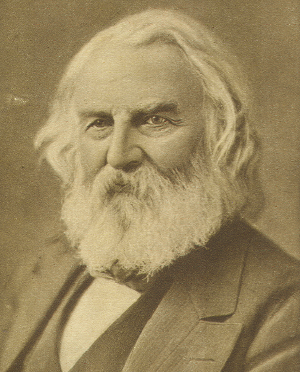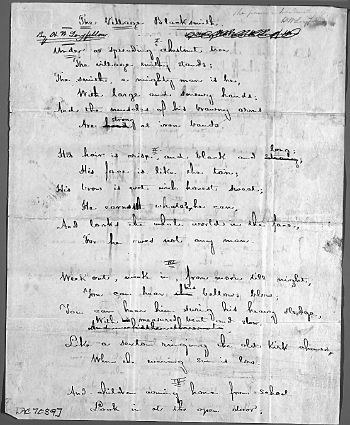Henry Wadsworth Longfellow
Henry Wadsworth Longfellow was an American poet who wrote many works that are still famous today, including The Song of Hiawatha, Paul Revere's Ride and Evangeline. He also wrote the first American translation of Dante Alighieri's Divine Comedy and was one of the five members of the group known as the Fireside Poets. Born in Maine, Longfellow lived for most of his life in Cambridge, Massachusetts, in a houseoccupied during the American Revolution by General George Washington and his staff.
Early life and education
Longfellow was born in 1807, the son of Stephen and Zilpah (Wadsworth) Longfellow. He was born and grew up in what is now known as the Wadsworth-Longfellow House, a Federal Style house that was located on the corner of Hancock and Fore Streets in Portland, Maine. The house was demolished in 1955. Longfellow's father was a lawyer and his maternal grandfather Peleg Wadsworth Sr. was a general in the American Revolutionary War . He was descended from the Longfellow family who came to America in from Otley in Yorkshire, England and from Priscilla and John Alden, a Mayflower Puritan on his father's side.
The Longfellow family faith was Unitarian and Henry's younger brother Samuel became a minister in the Unitarian church. Samuel Longfellow later wrote Henry's biography and commented about his brother's spiritual life: "It permeated his life. His nature was at heart devout: his ideas of life and death, and of what lies beyond, were essentially cheerful, hopeful, optimistic. He did not care to talk much on theological points, but he believed in the supreme good in the world and in the universe."
Longfellow was enrolled in a "dame school" at the age of only three and by the age of six, when he entered the Portland Academy, he was able to read and write very well. He remained at the Portland Academy until the age of fourteen and entered Bowdoin College in Brunswick, Maine in 1822. At Bowdoin, he met Nathaniel Hawthorne, who became his lifelong friend.
First European tour and professorship at Bowdoin
After graduating in 1825, he was offered a professorship at Bowdoin College with the condition that he first spend some time in Europe for further language study. He toured Europe between 1826 and 1829 and upon returning, went on to become the first professor of modern languages at Bowdoin, as well as a part-time librarian. During his years at the college, he wrote textbooks in French, Italian, and Spanish and a travel book, Outre-Mer: A Pilgrimage Beyond the Sea. In 1831, he married Mary Storer Potter of Portland.
Second European tour and professorship at Harvard
In 1834, Longfellow was offered the Smith Professorship of French and Spanish at Harvard with the stipulation that he spend a year or so in Europe to perfect his German. Tragically, his young wife died during the trip in Rotterdam after suffering a miscarriage in 1835. When he returned to the United States, Longfellow took up the professorship at Harvard University. He began publishing his poetry, including "Voices of the Night" in 1839 and "Ballads and Other Poems", which included his famous poem "The Village Blacksmith", in 1841.
Marriages
Longfellow was a devoted husband and father with a keen feeling for the pleasures of home. But his marriages ended in sadness and tragedy — the first to Mary Potter, of Portland, who died in 1835.
Several years later, in 1843, Longfellow then married Frances "Fanny" Appleton, daughter of the merchant Nathan Appleton, who bought the Craigie House, overlooking the Charles River as a wedding present to the pair. While he was courting Miss Appleton, he frequently walked from Harvard to her home in Boston, crossing the river via the West Boston Bridge. That bridge was subsequently demolished and replaced in 1906 by a new bridge, which was eventually renamed as the Longfellow Bridge. His love for Fanny is evident in the following lines from Longfellow's only love-poem, the sonnet "The Evening Star," which he wrote in October, 1845: "O my beloved, my sweet Hersperus!/ My morning and my evening star of love!"
Longfellow settled in Cambridge, where he remained for the rest of his life, although he spent summers at his home in Nahant.
He retired from Harvard in 1854, devoting himself entirely to writing. He was awarded an honorary doctorate of Laws from Harvard in 1859.
The death of Frances
On a hot July day, while sealing her daughter's curls in an envelope, Fanny's light summer dress caught fire. Longfellow attempted to extinguish the flames, badly burning himself. Fanny died the next day, on July 10, 1861. Longfellow was devastated by her death and never fully recovered. The strength of his grief is still evident in these lines from a sonnet, "The Cross of Snow" (1879) which he wrote eighteen years later to commemorate her death:
- Such is the cross I wear upon my breast
- These eighteen years, through all the changing scenes
- And seasons, changeless since the day she died.
The death of Longfellow
Henry Wadsworth Longfellow died March 24, 1882 and is buried at Mount Auburn Cemetery, Cambridge, Massachusetts. In 1884 he was the first American poet for whom a commemorative sculpted bust was placed in Poet's Corner of Westminster Abbey in London.
Longfellow's home in Cambridge, the Longfellow National Historic Site, is a U.S. National Historic Site, National Historic Landmark, and on the National Register of Historic Places. A 2/3 scale replica was built in Minneapolis, Minnesota at Minnehaha Park and once served as a centerpiece for a local zoo.
Longfellow's work
Early on, Henry Longfellow's talent and passion for writing was greatly influenced by his reading of Washington Irvings "Sketchbook". The Portland Gazette published Henry's first poem, "The Battle of Lovell's Pond" when he was just a young teen.
His work was immensely popular during his time and is still somewhat today, but many modern critics consider him too sentimental. His poetry is based on familiar and easily understood themes with simple, clear, and flowing language. His poetry created an audience in America and contributed to creating American mythology. In his majesty of language and mastery of craft Longfellow's works connected to the national conscience and imagination. Some of Longfellow's works were set to music by the composers Liszt (introduction to 'The Golden Legend'), Elgar, Mendelssohn, and Ives. He wrote the Unitarian hymn "All are Architects of Fate".
One of Longfellow's favorite metaphors is the backward glance. People in the present look back into their distant pasts and make a discovery. What had once been history — political, conflicted, sad, and bloody — could now be seen as imaginative myth: ordered, noble, and a source of strength. Longfellow wrote for a young nation ready to make this backward glance.
Roberto Rabe, in a biographical writing of Longfellow, explains the qualities and general appeal of the writers works thus: "His poems are easily understood; they sing their way into the consciousness of those who read them. Above all, there is a joyousness in them, a spirit of optimism and faith in the goodness of life which evokes immediate response in the emotions of his readers."
Longfellow was a contemporary of some of the most influential trailblazers in the realm of literature and political and spiritual new movements of his day. Centered in Boston, there was a group known as the Transcendentalists, a 19th century movement of Idealism which was expressed through the arts freethinking apart from the traditional conventions of life whether concerning the institution of traditional Protestantism of the time, women's rights, or the issues of slavery. Although Longfellow was not a rebel activist himself, he was a friend or colleague of those who were closer to the action of the American Renaissance. Ralph Waldo Emerson, Henry David Thoreau, Margaret Fuller and Nathaniel Hawthorne were Unitarian Transcendentalists in Longfellows circle of peers and friends. In 1842 Longfellow showed his support of the Abolitionist movement when wrote Poems on Slavery.
In Boston in 1957 Henry Wadsworth Longfellow, along with Ralph Waldo Emerson, Oliver Wendell Holmes, Sr. and James Russell Lowell founded what was to become one of the most enduring of all literary and cultural publications in America, "The Atlantic Monthly "(also known as the "Atlantic"). Several of Longfellow's poems were first published in "The Atlantic Monthly" including Santa Philomena, Paul Revere's Ride and the Leap of Roushan Beg among others.
Most of Longfellow's works were highly regarded by critics which won him respect, recognition and great honors in his lifetime. Even the British monarch, Queen Victoria invited him to have a private visit at tea with her. However popular, Longfellow also had his detractors and Edgar Allen Poe was outspoken in his critcism of Longfellow's "Voices of the Night" and even accused Longfellow of plagerism in his poetic drama "The Spanish Student".
Quotes and manuscript
|
And children coming home from school |
The regularity in meter and rhyme of Henry Wadsworth Longfellow's style of writing lends itself wonderfully to memorization, recitation and quotation. This quotation from 'The Children's Hour' describes a scene in his home at bedtime that reveals Longfellow's loving and devoted heart for his children:
"I have you fast in my fortress, And will not let you depart, But put you down in the dungeon In the round-tower of my heart"
External links
- Works by Henry Wadsworth Longfellow. Project Gutenberg
Credits
New World Encyclopedia writers and editors rewrote and completed the Wikipedia article in accordance with New World Encyclopedia standards. This article abides by terms of the Creative Commons CC-by-sa 3.0 License (CC-by-sa), which may be used and disseminated with proper attribution. Credit is due under the terms of this license that can reference both the New World Encyclopedia contributors and the selfless volunteer contributors of the Wikimedia Foundation. To cite this article click here for a list of acceptable citing formats.The history of earlier contributions by wikipedians is accessible to researchers here:
The history of this article since it was imported to New World Encyclopedia:
Note: Some restrictions may apply to use of individual images which are separately licensed.
- www.distewart.com/longfellow/LongfellowBio.htm
- eclecticesoteria.com/longfellow.html.
- www.online-literature.com/henry_longfellow/
- www.mainehistory.org/house_longfellows.
- Sermon. Rev Joan R. Gelbein UU Church of Arlington. "Margaret Fuller: American Renaissance Woman". January 25, 1998
- The Connection/National Public Radio. Henry Wadsworth Longfellow. September 18, 2000. Commentary by Dick Gordon (host) and J.D. McClatchy (Poet) Chancellor of American Academy of Poets and John Hollander (Poet) Professor of English Lit. Yale University.
- www.uuquincy.org/projects/stamps/9longfellow.htm





